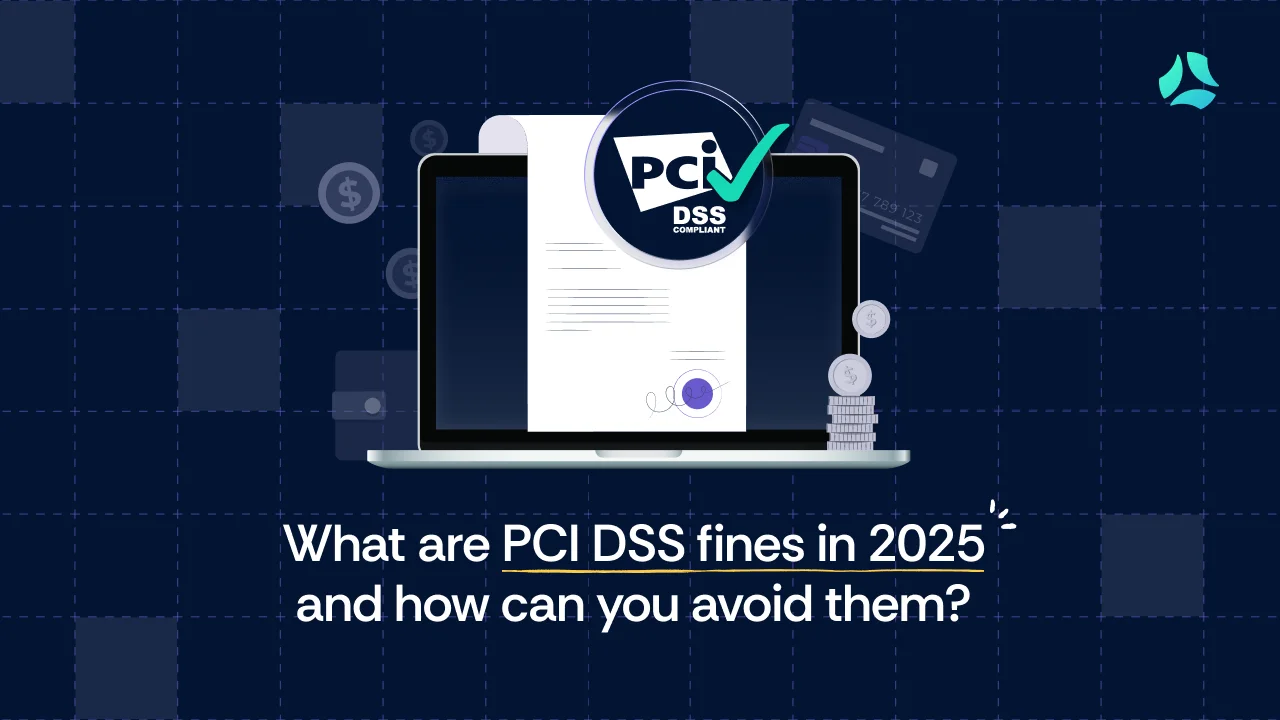What are PCI DSS fines in 2025 and how can you avoid them?

Every time a customer swipes, taps, or enters their card details online, organizations are entrusted with sensitive financial data. That trust comes with a critical responsibility to prioritize data security.
The Payment Card Industry Data Security Standard (PCI DSS) is a set of security requirements designed to protect environments where cardholder data is stored, processed, or transmitted. Created by major card brands, PCI DSS applies to all businesses—large or small—that handle payment card information.
Compliance is contractually mandatory. Failing to meet PCI DSS can trigger severe penalties. For example, non-compliant merchants often face fines in the range of $5,000–$100,000 per month. These costs (and related consequences) pose serious risks for any card-accepting business.
The cost of non-compliance in modern payment ecosystems
Non-compliance penalties start modestly but escalate rapidly.
Industry reports note that initial fines after a breach typically range $5,000–$10,000 per month, jumping to $25,000–$50,000 per month by months four to six, and $50,000–$100,000+ monthly if issues persist.
Smaller merchants commonly incur $5,000–$100,000 per month in recurring fines, while major breaches have led to multi-million‑dollar penalties. In extreme cases, fines or related regulatory penalties can approach half a million dollars per incident.
Beyond direct fines, non-compliance carries steep hidden costs. Mandatory forensic investigations and breach remediation can cost hundreds of thousands more, and companies often face costly legal actions. For example, Target’s 2013 breach (tied to PCI gaps) ultimately cost the company roughly $292 million.
Reputation damage is also significant: studies show about 66% of consumers would lose trust in a company after a data breach. Higher credit-card processing fees, increased transaction rates, or even loss of merchant account privileges may follow compliance failures. The combined direct and indirect costs of PCI DSS violations can easily dwarf the expense of proactive compliance.
Why PCI DSS isn’t just for large enterprises?
PCI DSS requirements apply to every organization that handles payment cards, not just big retailers. Whether you’re a large corporation or a local cafe taking a few transactions per week, you must be compliant. Merchants fall into compliance levels based on transaction volume, but all levels are subject to the same security standards and potential fines.
In practice, this means a small online store is liable for the same encryption, firewall, and auditing requirements as a multinational. Even “Level 4” merchants (under 20,000 transactions per year) can incur monthly penalties of $5,000–$100,000 for non-compliance. Ignoring PCI DSS is therefore risky at any scale: startups and SMEs face the same fines and breach liabilities as larger firms if they mishandle card data.
What triggers PCI compliance fines?
PCI DSS fines are typically imposed when an organization fails to meet required security obligations. Common triggers include:
- Cardholder data breaches or exposures: Any incident that leaks credit card data (e.g., due to malware, hacking, or insecure storage) often triggers penalties. For example, storing unencrypted PANs or CVV codes is a direct violation. Even sending card data without strong encryption or proper isolation (weak segmentation) can count as a breach of PCI rules.
- Non-adherence to technical controls: Skipping required security controls, such as neglecting firewalls, vulnerability scans, patching, or multi-factor authentication (MFA) – can incur fines. PCI regulations mandate regular system scans and security measures; failing these checks (or running non-compliant payment applications) is a violation. For instance, outdated software or missing network security controls puts card data at risk and can prompt fines.
- Failure to submit required reports (SAQs/ROCs): PCI DSS requires merchants to validate compliance annually. Small merchants typically file a Self-Assessment Questionnaire (SAQ), while large ones need a Report on Compliance (ROC) from a QSA. Failing to complete and submit these compliance reports to the acquiring bank on schedule is a violation. If you never file an SAQ or ROC as required, or if the report is incomplete, fines can be levied.
- Late or no breach reporting: If a breach or security incident occurs, merchants must report it promptly (often within hours or days, per card brand rules). Missing that deadline or hiding the incident can lead to steep penalties. The PCI rules explicitly impose fines for “failing to report a breach within the specified time”. Delays in notifying your bank or the card brands about a compromise will be treated as a serious violation.
Any significant gap in compliance, whether a technical lapse or a reporting failure, can therefore trigger PCI fines. The payment brands and acquiring banks monitor adherence closely, and non-conformance (even if unintentional) is met with fines to enforce remediation.
Who imposes the fines?
PCI DSS fines are not issued by the PCI Security Standards Council. Instead, the card networks and acquiring banks enforce penalties. Major payment brands (Visa, Mastercard, AmEx, Discover, JCB etc) set the rules and can decide when fines are warranted. They levy fines on the acquiring (merchant) bank for non-compliance. The acquirer then passes those costs (and any extra fees) down to the merchant.
For example, NordLayer explains that if Visa finds a merchant lacking sufficient encryption, “Visa will technically fine the merchant’s bank… however, the bank will then pass on the fine to the business in question.”
Similarly, SecurityCompass notes that fines are imposed “by acquiring banks and payment processors, not the PCI SSC.”
Thus, responsibility cascades: card brands set penalties, banks enforce them, and merchants (and their service providers) ultimately pay. An acquiring bank is contractually responsible for its merchants’ PCI compliance, so it has the authority to charge the merchant when a violation occurs.
In severe cases, banks can also suspend or revoke a merchant’s account if compliance isn’t restored. The financial liability for PCI fines flows from the card brands to banks or processors to the merchant or service provider responsible for the violation.
How to prevent PCI DSS violations?
Strong security practices are the best defense against fines. Key measures include:
- Regular gap assessments: Conduct routine PCI DSS audits or gap analyses to uncover any shortcomings. Proactive assessments (internal or with a QSA) let you fix gaps before fines or breaches occur.
- Employee training and awareness: Educate all relevant staff (especially those handling card data) on PCI requirements and security best practices. Inadequate training is a common failure point. Ongoing training and a security-aware culture help prevent accidental violations. For example, ensuring everyone knows not to store CVVs or share credentials can close obvious loopholes.
- Network segmentation and access control: Limit the cardholder data environment (CDE) by isolating it from the rest of the network. If segmentation is insufficient, your entire network may be in scope for PCI, which is a known compliance risk. Implement the principle of least privilege: only give CDE access to staff who genuinely need it, and use firewalls or VLANs to segregate systems. Strong access controls and MFA for any CDE entry point will also help meet PCI requirements.
- Keep up with PCI DSS updates: PCI DSS evolves. The latest version (4.0, effective 2024) introduced new requirements for continuous monitoring, stronger encryption, and risk-based controls. Organizations should review the PCI SSC’s v4.0 changes and implement relevant enhancements (e.g., broader MFA, longer password lengths, more frequent testing). Maintaining all existing controls while adopting the new ones is crucial. Treat PCI DSS as a living program, continuously updated and enforced, rather than a one-time audit.
By staying vigilant through regular audits, up-to-date technology, and educated staff, businesses can avoid the missteps that trigger fines.
Role of automation in avoiding PCI fines
Modern compliance platforms continuously scan your infrastructure for deviations from PCI requirements and immediately flag problems. This means issues (like a suddenly open port or missing encryption setting) are caught instantly, rather than after a quarterly audit.
Automation also handles routine tasks: it tracks system changes and user activities automatically, simplifying the audit trail and reducing human error. Many tools provide pre-built policy templates and checklists to standardize documentation, ensuring no required control is forgotten on paper. Dashboards and reports give compliance teams visibility into the organization’s overall status. In practice, automated monitoring and alerts empower businesses to close gaps before they lead to fines.
How Scrut helps you stay fine-free?
Scrut’s compliance automation platform is built to tackle PCI DSS requirements head-on. Key features include:
- Pre-built PCI frameworks and policies. Scrut offers a library of 75+ ready-made InfoSec policies mapped to PCI DSS controls. Organizations can adopt these templates and customize them, jump-starting their security program without having to write policies from scratch.
- Continuous control monitoring. Scrut continuously evaluates your cloud environment for PCI compliance gaps. Its automated monitoring engine identifies issues in real time and sends configurable alerts so you can remediate immediately. This keeps your compliance posture up to date, not just at audit time.
- Automated evidence collection. With integrations across cloud services and applications, Scrut automates roughly 80% of the evidence gathering needed for PCI audits. Logs, configurations, and test results are pulled into the system automatically, eliminating tedious manual collection and reducing errors.
- Centralized compliance dashboard. Scrut centralizes all PCI evidence and status information in one place. You can upload scan results, view collected logs, and track policy attestations together. A real-time dashboard provides a unified view of your compliance posture, including vendor security, employee training completion, and outstanding tasks. This transparency makes it easy to prepare for audits and demonstrate a fine-free track record to card brands and banks.
By leveraging Scrut’s pre-built frameworks, automation, and monitoring, organizations can maintain PCI DSS compliance continuously. Stay audit-ready and fine-free with Scrut.
Avoid costly PCI DSS fines and streamline your compliance journey with Scrut’s automated controls, evidence collection, and real-time dashboards.
Schedule a demo today to see how Scrut can simplify your PCI DSS compliance.


















